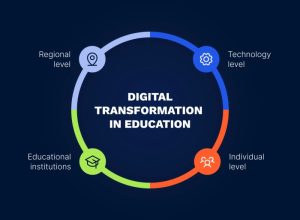
Exploring the pivotal role of technology in supporting special education opens up a world of possibilities for students with diverse learning needs. From personalized learning experiences to innovative assistive technologies, the impact of technology is profound and transformative.
As we delve deeper into the realm of special education and technology integration, a clearer understanding emerges of how these tools can revolutionize the educational landscape for students with disabilities.
Introduction to the role of technology in supporting special education
Technology plays a crucial role in enhancing learning experiences for students with special needs by providing personalized learning opportunities and access to assistive technologies.
Personalized Learning Opportunities
Technology allows for individualized learning experiences tailored to the unique needs and abilities of students with disabilities. Adaptive software and online platforms can adjust content and pace to support each student’s learning style.
Assistive Technologies
There are various assistive technologies commonly used in special education to support students with disabilities. Examples include:
- Augmentative and Alternative Communication (AAC) devices for students with speech or language impairments.
- Screen readers and text-to-speech software for students with vision impairments.
- Specialized keyboards and switches for students with physical disabilities.
- Interactive whiteboards and educational apps for interactive and engaging learning experiences.
Benefits of technology in special education

Technology plays a crucial role in enhancing the educational experience for students with special needs. It provides various benefits that contribute to their overall development and success.
Improving communication skills for students with special needs
Technology offers innovative tools and applications that help students with special needs improve their communication skills. For example, speech-to-text software can assist those with speech impairments in expressing themselves more effectively. Additionally, communication devices with picture symbols or text-to-speech features enable non-verbal students to communicate their thoughts and needs.
Fostering independence and promoting self-esteem among students with disabilities
Technology empowers students with disabilities to become more independent in their learning and everyday tasks. For instance, assistive technology devices like smart pens or interactive whiteboards allow students to take notes, organize information, and complete assignments without relying heavily on others.
This independence boosts their self-esteem and confidence, leading to a more positive attitude towards learning and personal growth.
Enhancing engagement and interactivity in learning
Technology makes learning more engaging and interactive for special education students through educational games, simulations, and multimedia resources. These interactive tools cater to various learning styles and preferences, making the learning process more enjoyable and effective. For example, virtual reality applications can create immersive learning experiences that stimulate students’ interest and motivation to explore new concepts and ideas.
Challenges and considerations in implementing technology in special education
Implementing technology in special education settings comes with its own set of challenges and considerations that need to be taken into account to ensure successful integration. These challenges can range from technical issues to ensuring inclusivity and accessibility for all students with disabilities.
Identifying potential barriers to technology integration
- Lack of training and support for teachers in using technology effectively in special education classrooms.
- Financial constraints in acquiring and maintaining specialized technology tools for students with disabilities.
- Resistance to change among educators and administrators who may be unfamiliar or uncomfortable with integrating technology into teaching practices.
The importance of accessibility and inclusivity
When selecting technology tools for students with disabilities, it is crucial to prioritize accessibility and inclusivity to ensure that all students can benefit from these tools.
- Choosing technology that is compatible with assistive devices and software to support different types of disabilities.
- Providing training and resources to ensure that teachers can effectively use technology to meet the diverse needs of students with disabilities.
- Considering the individual needs of each student and customizing technology solutions to address their specific challenges and goals.
Strategies for overcoming challenges related to technology implementation
- Offering professional development opportunities for teachers to enhance their digital literacy skills and knowledge of assistive technology.
- Collaborating with technology experts and specialists to provide ongoing support and troubleshooting for educators in special education settings.
- Establishing a team approach that involves parents, teachers, and support staff in the selection and implementation of technology tools to ensure a comprehensive and inclusive approach.
Innovative technologies for special education
Virtual reality (VR) and augmented reality (AR) have revolutionized the way special education programs are conducted, offering immersive and interactive experiences for students with diverse needs. Educational apps and software tailored to the specific requirements of students with special needs have also proven to be highly beneficial.
Additionally, adaptive technology solutions cater to different learning styles, providing personalized support to enhance the learning experience in special education.
Virtual Reality (VR) and Augmented Reality (AR) in Special Education
Virtual reality (VR) and augmented reality (AR) technologies have the potential to create simulated environments that help students with special needs engage in interactive learning experiences. These technologies can offer a safe space for students to practice real-life scenarios, improve social skills, and enhance sensory experiences.
For example, VR can simulate historical events for history lessons or create 3D models for science experiments, making complex concepts more accessible and understandable for students with special needs.
Educational Apps and Software for Special Education
Educational apps and software designed specifically for students with special needs provide a wide range of benefits, including personalized learning experiences, interactive activities, and skill-building exercises. These tools cater to individual learning goals and can be adjusted to accommodate different learning styles, making education more engaging and effective for students with special needs.
For instance, apps that offer visual and auditory prompts can support students with autism spectrum disorder in improving communication and social skills.
Adaptive Technology Solutions for Different Learning Styles
Adaptive technology solutions play a crucial role in supporting students with special needs by providing customized learning experiences based on their unique requirements. These solutions can include text-to-speech software, screen readers, adaptive keyboards, and alternative input devices that cater to diverse learning styles and abilities.
By adapting to the individual needs of students, adaptive technology solutions help create an inclusive learning environment where every student can thrive and reach their full potential.
Role of technology in professional development for special education teachers
Technology plays a crucial role in enhancing the professional development of special education teachers by providing innovative tools and resources to support their continuous growth and learning. Incorporating technology into teacher training programs is essential to equip educators with the necessary skills to effectively meet the diverse needs of students with disabilities.
Importance of incorporating technology skills into special education teacher education programs
- Technology integration in teacher education programs helps special education teachers develop proficiency in using assistive technologies to support students with disabilities.
- Access to online platforms and resources enhances collaboration among educators, allowing them to share best practices and strategies for improving student outcomes.
- Professional development opportunities through virtual workshops and webinars enable teachers to stay updated on the latest research and interventions in the field of special education.
Examples of online platforms and resources for training in special education
-
Understood.org
offers free resources, webinars, and expert advice for educators working with students with learning and attention issues.
-
EDWeb.net
provides a platform for special education teachers to connect, collaborate, and access professional development resources tailored to their specific needs.
-
CAST Professional Learning
offers online courses and workshops on universal design for learning (UDL) and assistive technology to support inclusive practices in special education classrooms.
Future trends and possibilities of technology in special education
Technology continues to advance rapidly, opening up new opportunities for supporting students with disabilities in the field of special education. As we look ahead, several trends and possibilities are emerging that have the potential to revolutionize the way we approach teaching and learning for individuals with diverse needs.
Emerging technologies such as artificial intelligence (AI) and machine learning
Artificial intelligence and machine learning hold immense promise in the realm of special education. These technologies can be harnessed to provide personalized learning experiences tailored to the unique abilities and challenges of each student. By analyzing data and adapting to individual learning styles, AI and machine learning can help educators create more effective intervention strategies and support mechanisms for students with disabilities.
- AI-powered tools can assist in automating tasks and providing real-time feedback to both students and teachers, enhancing the learning process.
- Machine learning algorithms can identify patterns in student performance and behavior, enabling educators to make data-driven decisions to improve outcomes.
- Virtual reality and augmented reality applications powered by AI can create immersive learning environments that cater to different sensory needs and learning preferences.
Potential of personalized learning platforms for special education
Personalized learning platforms have the potential to revolutionize the way special education is delivered by catering to the diverse needs of students with disabilities. These platforms can adapt content, pacing, and teaching methods to match individual learning styles, preferences, and abilities, fostering greater engagement and achievement among students.
By offering tailored learning experiences, personalized platforms empower students to take ownership of their learning journey and progress at their own pace.
Contribution of technology to creating inclusive learning environments
Technology plays a crucial role in creating more inclusive and accessible learning environments for students with disabilities. Through the use of assistive technologies, adaptive tools, and accessible digital resources, educators can ensure that all students have equal opportunities to learn and participate in educational activities.
- Accessible e-books, screen readers, and text-to-speech tools can provide students with varying levels of visual impairment or reading difficulties with alternative ways to access educational content.
- Communication devices and assistive technology apps can support students with speech and language impairments in expressing themselves and engaging with classroom activities.
- Collaborative online platforms and virtual learning environments enable students with mobility impairments or health conditions to participate in group projects and interact with peers in a digital space.
Final Review
In conclusion, the intersection of technology and special education offers a promising future where inclusivity, accessibility, and personalized learning are at the forefront of educational practices. Embracing these advancements paves the way for a more equitable and empowering learning environment for all students.
Quick FAQs
How can technology enhance communication skills for students with special needs?
Technology provides various tools like communication apps and devices that support students in expressing themselves effectively, improving their communication skills.
What are some innovative technologies used in special education?
Innovative technologies like virtual reality (VR) and adaptive educational software are increasingly utilized to cater to the diverse needs of students with disabilities, offering engaging and effective learning experiences.
Why is accessibility crucial when selecting technology tools for special education?
Accessibility ensures that all students, regardless of their abilities, can fully engage with the learning materials, promoting inclusivity and equal educational opportunities.







